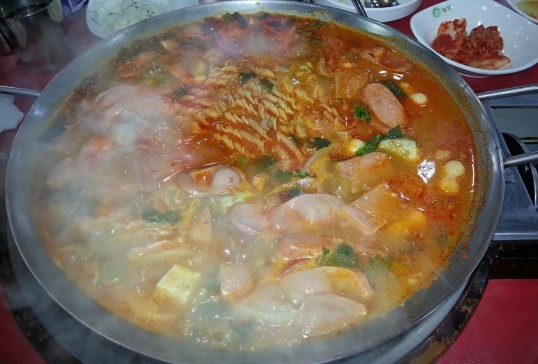Have you tried 부대찌개 (budae jjige)? The first time I’ve tried it, my husband told me the story behind this mouth-watering dish, also called “camp stew” or “army base stew“. Some Koreans call it “Johnson tang” (존슨 탕), putting together the American family name Johnson and Korean word for soup or stew.
After the Korean war, people in Korea had nothing much to eat. They were going hungry, so they gathered leftover food from U.S military bases such as ham, hotdogs, SPAM, etc. They boiled these and cooked them with kimchi and gochujang (고추장: red chilli paste), or whatever they had; thus the famous spicy stew, “budae jjige”, was made.
Nowadays, there are a number of “budae jjige” restaurants in South Korea, but of course, the meat used in making the stew do not come from trash. More ingredients are added, like cheese, “ramyon” (라면: Korean instant noodle), sausages, bacon, canned beans, minced beef, macaroni, “tofu” or bean curd, “tteok” (떡: rice cake) mushrooms and other vegetables.
My husband brought me to a big “budae jjige” restaurant in Hyewadong, but according to him, and from what I’ve read, the best place to eat this stew is in Uijeongbu where there are many U.S. army bases. In fact, there is an area there known as “Budae jjige street”. Perhaps, one of these days, hubby and I will visit the place, and we might just try “Uijeongbu budae jjige”.
“Budae jjige” reminds us of Koreans’ resourcefulness and love for their culture. Who would think that the delicious stew we have come to like today started from scraps? Though the meat used in the dish are mostly American products, the stew has that unique spicy flavor and kimchi, of course, that makes it traditionally “Korean”.
Related articles
- Care for Some Dog Soup? (chrissantosra.wordpress.com)
- Naengmyon: Cold Noodles (chrissantosra.wordpress.com)
- Juk: Korean Rice Porridge (chrissantosra.wordpress.com)
- How To Cook Korean Birthday Soup (chrissantosra.wordpress.com)
- Some Korean Food That Will Make Your Mouth Water (chrissantosra.wordpress.com)
- Learn How to Cook Korean Food from Maangchi (chrissantosra.wordpress.com)
- Budae Jigae- Korean Army Stew (hintofmitch.wordpress.com)
- Kimchi (lifesanadventure2.com)
- Stew it! (Tokyo) (mykonosfoodlab.com)
- Danish stew warms body, soul (reporternews.com)
- Slow cooked beef stew. (yumbotumbo.com)
- Beef and Butternut Squash Stew (unihomemaker.com)
- Harissa Beef Stew (cucinaceri.com)
- Kimchi – Part 1 (lifesanadventure2.com)
Filed under: Korean Food and Drink Tagged: bean curd, chilli paste, Jjigae, Korea, Korean, Korean War, South Korea, Stew, Uijeongbu, United States
![]()





Recent comments